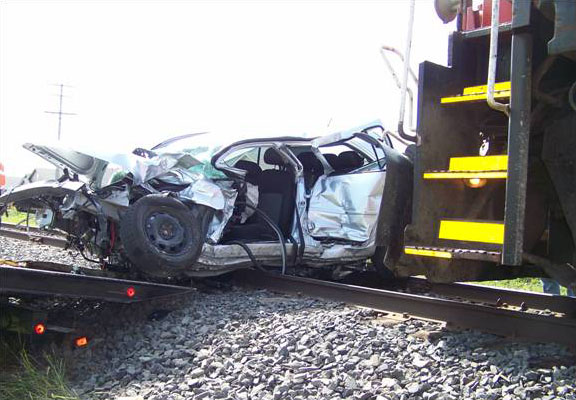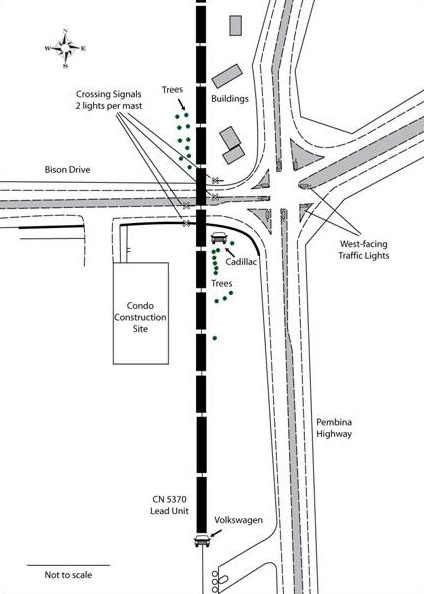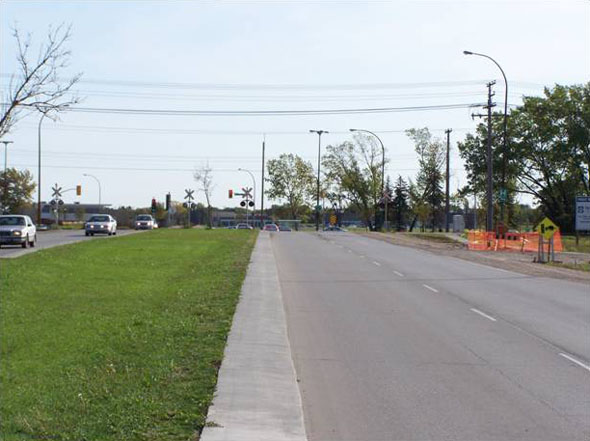Crossing collision
Canadian National Railway
Train L53241-09 South
Mile 3.66, Letellier Subdivision
Winnipeg, Manitoba
The Transportation Safety Board of Canada (TSB) investigated this occurrence for the purpose of advancing transportation safety. It is not the function of the Board to assign fault or determine civil or criminal liability. This report is not created for use in the context of legal, disciplinary or other proceedings. See Ownership and use of content. Masculine pronouns and position titles may be used to signify all genders to comply with the Canadian Transportation Accident Investigation and Safety Board Act (S.C. 1989, c. 3).
Summary
On 09 September 2008 at 1006 central daylight time, southbound Canadian National freight train L53241-09 struck an eastbound automobile travelling in the median lane at the Bison Drive level crossing. The automobile was pushed into another eastbound vehicle travelling in the curb lane. The first vehicle struck was destroyed and its lone occupant suffered serious injuries. The second vehicle was heavily damaged and its two occupants sustained minor injuries. There were no injuries to the train crew.
Ce rapport est également disponible en français.
Factual information
The Accident
On 09 September 2008 at approximately 1005 central daylight timeFootnote 1, Canadian National (CN) train L53241-09 was travelling southward at 27 mph en route from Symington Yard in Winnipeg, Manitoba (MB) to Emerson, MB.
As the train approached the Bison Drive crossing at Mile 3.66 on the Letellier Subdivision with the locomotive bell activated, the crossing signals commenced operation. Westbound vehicles stopped at the crossing. However, eastbound vehicles continued to enter the crossing in both the median and curb lanes. As the train entered the crossing with the locomotive horn sounding, the lead locomotive struck a Volkswagen Golf automobile travelling in the median lane, pushing it into a Cadillac CTS automobile travelling in the curb lane. The train brakes were placed in emergency and the train came to a stop approximately 800 feet south of the crossing with the Volkswagen wedged under the coupler of the lead locomotive (See Photo 1).
Police, fire, and emergency medical personnel responded to the accident. The Volkswagen was destroyed. Its critically-injured driver was trapped in the vehicle. The emergency responders were not in possession of equipment (such as the “jaws of life”) to aid in extricating the driver. Once freed, the driver was transported to hospital.
The force of the impact propelled the Cadillac into a ditch on the southeast side of the crossing. Its two occupants were transported to hospital with minor injuries. The locomotive sustained minor damage and the crew on the train was uninjured.
At the time of the occurrence, visibility was clear. The temperature was 15°C and the wind was calm.
Crew and train information
The crew on train L53241-09 consisted of a locomotive engineer and a conductor. Both crew members were qualified for their respective positions, met current fitness and rest standards, and were familiar with the territory.
The train consisted of two locomotives and 62 cars. It weighed 5190 tonnes and was 4097 feet in length. The train had received a full mechanical inspection and an air brake test prior to its departing CN's Symington Yard. Both locomotives and all cars on the train were in a serviceable condition.
Letellier Subdivision
The Letellier Subdivision commences at Portage Junction in Winnipeg and extends 62.1 miles south to Emerson, MB. The method of control is the Occupancy Control System (OCS) authorized by the Canadian Rail Operating Rules (CROR) and supervised by a rail traffic controller (RTC) located in Edmonton, Alberta. Maximum subdivision speed was 25 mph. There is an average of two trains per day.
Crossing information
Bison Drive is a four-lane divided arterial roadway that crosses the Letellier Subdivision at a 90-degree angle. The road ascends at between one-half and one per cent approaching the crossing.
The crossing is located immediately adjacent to, and approximately 40 metres west of, the Pembina Highway (see Figure 1). This highway is the main north/south route through the city of Winnipeg. When travelling eastward on Bison Drive, the traffic signals at the Pembina Highway intersection are visible to motorists prior to their passing over the railway crossing (see Photo 2).
The posted speed on Bison Drive was 60 km/h in the vicinity of the crossing. Weekday traffic (2004 counts) averaged 18 300 vehicles per day, with 9450 of those vehicles travelling eastward. Since 2004, there had been significant residential and commercial development in the area. Bison Drive is the main entrance into the University of Manitoba.
Crossing signals and approaches
The Bison Drive crossing was equipped with four sets of flashing light emitting diode (LED) lights, four reflectorized crossing signs, and two warning bells. The lights and signs were located on masts positioned adjacent to the median and curb lanes for both the east and west approaches (see Photo 2). There were crossing advance warning signs posted on each side of the eastbound approach, located 200 metres from the crossing.
The crossing warning signal system used DC track circuits, interconnected with the traffic lights at the intersection with the Pembina Highway. When a train approached the crossing, the interconnection ensured that the highway traffic lights for eastbound traffic on Bison Drive defaulted to green. This was to prevent the eastbound vehicles from being blocked back onto the railway tracks. This system was installed in the mid-1970s, with the crossing signals upgraded from incandescent lights to LED lights in June 2005.
Immediately to the north of the railway crossing, there was a row of trees which restricted eastbound drivers' sightlines to the north. A medium-rise condominium under construction restricted drivers' sightlines to the south.
Drivers' actions
Drivers travelling eastward had continued over the railway tracks while the signals were operating and proceeded through the Pembina Highway traffic intersection. An eastbound vehicle had just cleared the median lane in front of the train when the following Volkswagen was struck by the lead locomotive.
The Cadillac travelling in the curb lane was crossing the railway tracks when it was struck by the Volkswagen. Its driver was preparing to make a right-hand turn at the highway intersection. Data obtained from the Cadillac's event recorder indicated that it had slowed from 80 km/h to 60 km/h, with a light brake application prior to the crossing, and was proceeding over the crossing at 60 km/h.
A traffic survey following the accident determined that, at this location, most eastbound drivers on Bison Drive had adapted to the threat presented by relatively infrequent trains and growing highway traffic. Drivers chose to give precedence to traffic flow and the highway traffic signals over the activated railway crossing signals.
Summary of TSB database of Bison Drive occurrences
This was the sixth TSB-reported train/vehicle collision at this crossing since 1986 (see Appendix A). Four of the accidents involved vehicles that were proceeding eastward. Prior to the 2008 accident, the most recent accident was in 2004. The time of day of these accidents varied. In the 1991 accident, a second vehicle following the eastbound vehicle that was struck by the locomotive drove into the side of the locomotive.
Transport Canada crossing risk-assessment process
Transport Canada's (TC) Prairie and Northern Region uses an accident prediction model to prioritize the need for crossing safety improvement. In addition, TC modifies the ranking to include traffic interconnections and other factors not accounted for in the model. Bison Drive had been identified and was on the list as a higher priority crossing.
In 2005 the railway, and in 2006 the road authority, applied to TC for a funding contribution to upgrade the crossing to include four gates, back lights, and constant warning time track circuitry. The estimated cost of these upgrades was $234 000, of which TC could fund up to 80 per cent. However, TC has limited funds available and prioritizes all outstanding applications each year. The railway and road authorities do not normally construct before funding is granted, as there is no guarantee that the funds will be provided.
Analysis
In this occurrence, neither track conditions, train handling, nor equipment were found to be contributory to the accident. Therefore, the analysis will focus on driver behaviour and the adequacy of automatic warning devices at interconnected crossings.
The accident
As the train approached the Bison Drive crossing, it activated the railway crossing signal system. The interconnection between the crossing signals and the adjacent highway traffic signals ensured that the highway signal for eastbound traffic on Bison Drive was green. Westbound traffic stopped for the crossing signals. However, eastbound traffic continued to move through the crossing. The collision occurred when the drivers of the two motor vehicles, following the cues of the preceding traffic and not fully aware of the imminent danger of an approaching train, continued past the operating crossing signals and the median-lane vehicle was struck by the train.
The driver of the vehicle in the curb lane was preparing to make a right-hand turn at the highway intersection. Although aware that a train was approaching, the driver took a visual cue from the traffic in the median lane and continued onto the crossing. When the vehicle in the median lane was struck by the train, it was propelled into the vehicle in the curb lane.
When travelling on highways, vehicle operators rely on prominent visual cues to maintain a smooth traffic flow. In this accident, the drivers of both vehicles were following other vehicles that had just cleared the tracks in the median lane when they entered the railway crossing. Therefore, they did not perceive an imminent threat from the approaching train. They did not stop prior to the crossing although the warning signals were operating. Both drivers were following the flow of traffic and focused on negotiating the Pembina Highway traffic intersection beyond the crossing.
Eastbound vehicles at Bison Drive faced contradictory signals. The red flashing crossing signals required vehicles to stop, then to proceed only if it was safe to do so. However, eastbound drivers also faced the interconnected green highway signals and continuing traffic flow ahead of them. The interconnection of the highway and railway crossing signals and the traffic flow created an ambiguous environment where drivers did not acknowledge the crossing signals in an effort to successfully negotiate the traffic intersection.
Signal interconnection
Interconnection between crossing signals and highway signals is done at locations where red highway signal indications can cause traffic to be backed-up foul of the railway tracks. In some locations, signals are interconnected without physical barriers at the crossing. In such circumstances, drivers are presented with two visual cues that it is safe to proceed (vehicles ahead and the green traffic light) and one visual defence (flashing red lights) warning drivers of the approaching train. These mixed indications may encourage vehicles to continue onto the crossing instead of stopping clear of the railway tracks. Where railway and highway crossing signals are interconnected without the use of a physical barrier at the crossing, ambiguity caused by conflicting visual cues increases the risk of a train/vehicle collision.
Impact of development
In areas where significant development occurs, traffic volumes will also increase significantly. These developments often are in proximity to existing railway infrastructure and can affect the safety of railway crossings. In these cases, the existing crossing signal system may no longer be sufficient to assure an adequate level of safety.
Findings
Findings as to causes and contributing factors
- The collision occurred when the drivers of the two motor vehicles did not recognize the imminent danger of an approaching train and continued past the operating crossing signals.
- Both drivers were following the flow of traffic and focused on negotiating the Pembina Highway traffic intersection.
- The interconnection of the highway traffic signals with the railway crossing signals and the traffic flow created an ambiguous environment where drivers discounted the crossing signals in an effort to successfully negotiate the traffic intersection.
Findings as to risk
- Where railway and highway crossing signals are interconnected without the use of gates, ambiguity caused by conflicting visual signals can increase the risk of a train/vehicle collision.
- Where substantial residential and commercial development occurs in proximity to railway crossings, the existing crossing signal system may become insufficient to assure an adequate level of safety.
Safety action taken
Canadian National and the road authority applied to Transport Canada for a financial contribution to improve the Bison Drive crossing with the addition of automatic gates and improved track circuits. Transport Canada has identified this crossing as a higher priority for funding in 2009.
This report concludes the Transportation Safety Board's investigation into this occurrence. Consequently, the Board authorized the release of this report on .
Appendices
Appendix A - Accident record for Bison Drive, Winnipeg
| Occurrence no. | Occurrence year | Accident type | Current summary |
|---|---|---|---|
| R86W0838 | 1986 | Crossing | Failed to stop at crossing. |
| R91W0431 | 1991 | Crossing | Light locomotive engine struck first vehicle. Following first impact, the locomotive (Unit 1143) was struck by a second vehicle. |
| R95W0048 | 1995 | Crossing | The lead locomotive of CN Train 533-4L-18 struck the right rear side of a station wagon. The vehicle passenger was transported by ambulance to hospital with undetermined injuries. The train was released at 2030 CST. |
| R03W0079 | 2003 | Crossing | CN freight train L-532-41-04 proceeding southward struck a gravel truck on the public crossing equipped with flashing lights and bells. No injuries were reported. Local police and CN officials responded. |
| R04W0139 | 2004 | Crossing | CN freight train L-532-41-22 struck a vehicle on Bison Drive equipped with flashing light signals and bells. Vehicle operator was transported by ambulance to hospital with undetermined but non-life threatening injuries. Local police, ambulance personnel, and CN officials responded. |
| R08W0181 | 2008 | Crossing | CN reported train L-532-41-09 proceeding on the Letellier Subdivision struck a vehicle at Bison Drive equipped with flashing light signals and bells. When struck, the force of the impact propelled the vehicle into a second vehicle. The lone occupant from the first vehicle was seriously injured and two occupants from the second vehicle sustained minor injuries. The injured were transported by ambulance to hospital. Local police, firefighters, ambulance personnel, and CN officials responded. |


